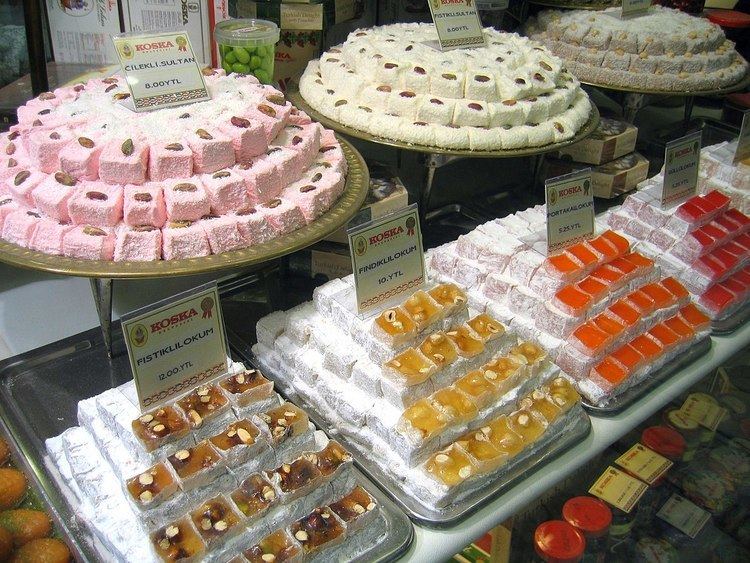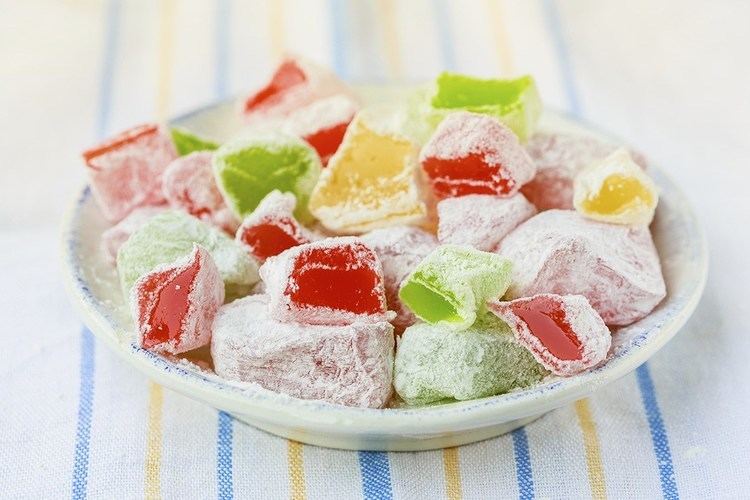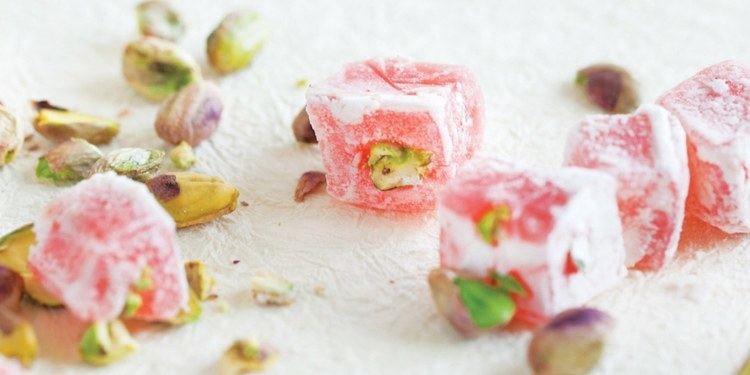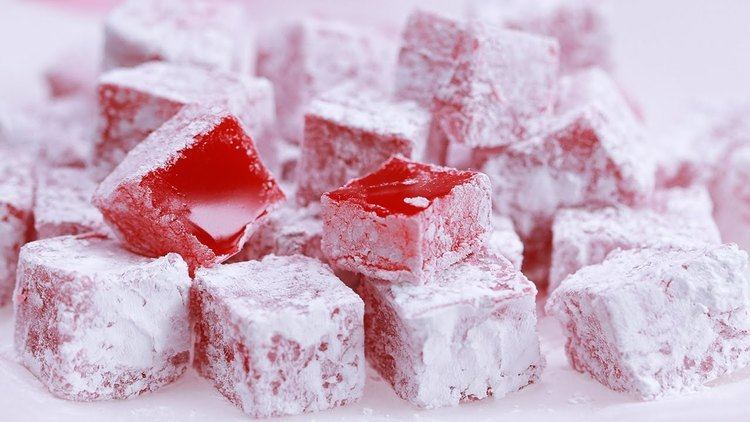Alternative names Lokum Created by Hacı Bekir Efendi Variations Multiple | Course Sweet | |
 | ||
Similar Baklava, Halva, Sugar, Lokma, Börek | ||
Chronicles of narnia turkish delights nerdy nummies
Turkish delight, lokum or rahat lokum and many other transliterations (Ottoman Turkish: رَاحَة الْحُلْقُوم rāḥat al-ḥulqūm, Turkish: Lokum or rahat lokum, from colloquial Arabic: راحه الحلقوم rāḥat al-ḥalqūm) is a family of confections based on a gel of starch and sugar. Premium varieties consist largely of chopped dates, pistachios, and hazelnuts or walnuts bound by the gel; traditional varieties are mostly flavored with rosewater, mastic, Bergamot orange, or lemon. The confection is often packaged and eaten in small cubes dusted with icing sugar, copra, or powdered cream of tartar, to prevent clinging. Other common flavors include cinnamon and mint. In the production process, soapwort may be used as an emulsifying additive.
Contents
- Chronicles of narnia turkish delights nerdy nummies
- Traditional turkish delight recipe
- History
- Name
- Bulgaria
- Greece
- Romania
- Former Yugoslavia and Albania
- North America
- Brazil
- Britain and other Commonwealth nations
- Protected geographical indication
- Related products
- In popular culture
- References

Traditional turkish delight recipe
History

The exact origin of these sweets is yet to be definitively determined; however, "lokum" comes from the Arabic Halkum or Al-Halkum. In the Arab world, Turkish delights are called rāḥat al-ḥulqūm (رَاحَة الْحُلْقُوم) which means "Throat Comfort".

According to the Hacı Bekir company, the sweets as they are known today were developed by Bekir Efendi, named Hacı Bekir, after performing the Hajj. He moved to Istanbul from his hometown Kastamonu and opened his confectionery shop in the district of Bahçekapı in 1777. The company still operates under the founder's name.

Tim Richardson, a historian of sweets, has questioned the claim of Hacı Bekir to be the creator of Turkish Delight, writing that "specific names and dates are often erroneously associated with the invention of particular sweets, not least for commercial reasons".

Ottoman confectionery was originally sweetened with honey and molasses, using water and flour as the binding agents, with rosewater, lemon peel and bitter orange as the most common flavors (red, yellow and green). Hacı Bekir introduced the use of glucose in 1811, shortly after it had been discovered by Gottlieb Kirchhoff.
Name

The Turkish names lokma and lokum are derived from the Arabic word luqma(t) and its plural luqūm meaning "morsel" and "mouthful" and the alternative Ottoman Turkish name, rahat-ul hulküm, was an Arabic formulation, rāḥat al-hulqūm, meaning "comfort of the throat", which remains the name in formal Arabic. In Libya, Saudi Arabia, and Tunisia it is known as ḥalqūm, while in Kuwait it is called كبده الفرس "chabdat alfaras" and in Egypt it is called malban (ملبن [ˈmælbæn]) or ʕagameyya and in Syria rāḥa. Its name in various Eastern European languages comes from Ottoman Turkish lokum or rahat-ul hulküm. Its name in Greek, λουκούμι (loukoumi) shares a similar etymology with the modern Turkish and it is marketed as Greek Delight. In Cyprus, where the dessert has protected geographical indication (PGI), it is also marketed as Cyprus Delight. In Armenian it is called lokhum (լոխում). Its name in Bosnian is rahat lokum, and derives from a very old confusion of the two Ottoman Turkish names found already in Ottoman Turkish; indeed this mixed name can also be found in Turkey today. Its name in Serbo-Croatian is ratluk, a reduced form of the same name. In Persian, it is called rāhat-ol-holqum (Persian: راحت الحلقوم).
In English, it was formerly alternatively known as Lumps of Delight.
Bulgaria
In Bulgarian, Turkish Delight is known as lokum (локум) and enjoys some popularity. While it presumably came with the Ottoman Empire, it may have arrived earlier, as the Middle East has been very influential to the country in terms of cuisine. Bulgaria produces its own brands of lokum, which may be plain or spiced with rose petals, white walnuts, or "endreshe".
Greece
In Greece, Turkish Delight, known as loukoumi [λουκούμι] has been a very popular delicacy since the 19th century, famously produced in the city of Patras, Patrina loukoumia, as well as on the island of Syros and the northern Greek cities Thessaloniki, Serres and Komotini but elsewhere as well. Loukoumi is a common traditional treat, routinely served instead of biscuits along with coffee. In addition to the common rosewater and bergamot varieties, Mastic-flavored loukoumi is available and very popular. Another sweet, similar to loukoumi, that is made exclusively in the town of Serres, is Akanés.
Romania
The Romanian word to describe this confection is rahat, an abbreviation of the Arabic rahat ul-holkum. However, in the Romanian language, the word rahat took a pejorative sense, in this case a euphemism that translates as shitty. According to linguist Lazăr Șăineanu, Turkish words which entered the Romanian language in the seventeenth century and eighteenth century became mostly obsolete and acquired a pejorative or ironic sense. Politically and socially, this weakened the influence of Ottoman society, and parts of the Ottoman Turkish language which had not had time to take root in the Romanian language took a touch of irony and became a mine for humorous literature. Rahat is eaten as is or is added in many Romanian cakes called cornulețe, cozonac or salam de biscuiţi.
Former Yugoslavia and Albania
In the countries of former Yugoslavia (Serbia, Croatia, Bosnia and Herzegovina, Montenegro, Republic of Macedonia and Slovenia), as well as in Albania, Turkish delight is known as rahat-lokum, ratluk or lokum. It was introduced during Ottoman rule of the Balkans and has remained popular. Today it is commonly consumed with coffee. Rose and walnut are the most common flavorings. The Macedonian sweets factory "Evropa" is known for its Turkish delight.
North America
The Nory Candy company in the Greater Los Angeles area has been producing Turkish Delights or Rahat Locum since 1964. The company produces different fruit and exotic flavors including rose and licorice as well a variety which include nuts such as Almonds, Pistachios, and Walnuts.
In 1930 two Armenian immigrants, Armen Tertsagian and Mark Balaban, founded Liberty Orchards of Cashmere, Washington, and began manufacturing "Aplets" (apple and walnut locoum) and "Cotlets" (apricot and walnut locoum). In 1984 they added the medley-flavored "Fruit Delights" line in strawberry, raspberry, orange, blueberry, peach, cranberry, and pineapple assortments. Although all of these confections are marketed under American-style brand names, they are referred to on product packaging as "Rahat Locoum".
In Canada, the Big Turk chocolate bar made by Nestlé consists of dark magenta Turkish Delight coated in milk chocolate, and is marketed as both Turkish delight and loukoum.
Brazil
The confection is known in Brazil as Manjar Turco, Delícia Turca, Bala de Goma Síria or Bala de Goma Árabe. As with most Middle Eastern dishes, it came with the Levantine Arab diaspora to Latin America.
Britain and other Commonwealth nations
Fry's Turkish Delight is marketed by Cadbury in the United Kingdom, Australia, and South Africa and can also be found in Canada and New Zealand, which is rosewater-flavoured, and covered on all sides in milk chocolate. UK production controversially moved to Poland in 2010.
Protected geographical indication
Despite its worldwide popularity and production in several countries, at present, the only protected geographical indication (PGI) for such a product is the name Λουκούμι Γεροσκήπου (Loukoumi Geroskipou) for Turkish delight made in Yeroskipou, Cyprus.
Related products
Turkish delight was an early precursor to the jelly bean that inspired its gummy interior.
There are gourmand perfumes that are based upon Turkish Delight, such as "Loukhoum" by Ava Luxe, "Loukhoum" by Keiko Mecheri, and "Rahät Loukoum" by Serge Lutens.
